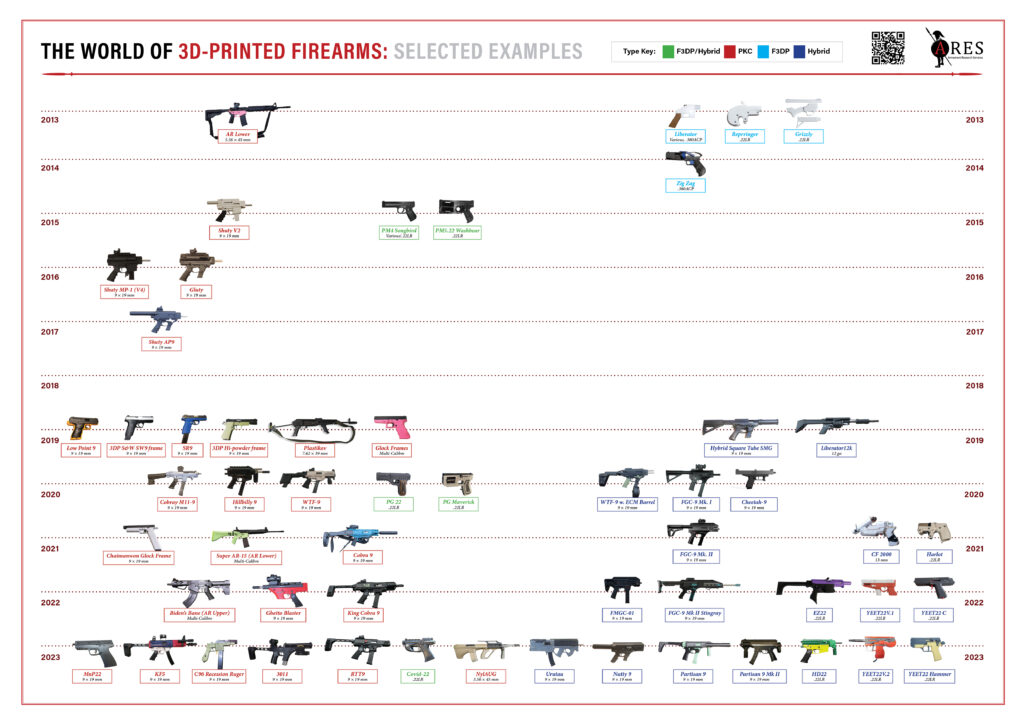3D-printed Firearms
ARES is a world leader in the identification, classification, and analysis of craft-produced and privately made firearms (PMFs), including 3D-printed firearms. ARES regularly consults to a range of law enforcement, intelligence, military, NGO, and media clients on a variety of arms and munitions related subjects, including 3D-printed firearms. We also deliver training courses and tailored briefings on 3DPF, from introductions to the underlying technologies, to analyses of specific designs or recovered examples. For more information, email: 3DPF@armamentresearch.com.
Click below to read our latest report on the subject, Desktop Firearms: Emergent Small Arms Craft Production Technologies (2023 update). Please note that this early access version of the updated report is subject to change.

We continue to produce original research and analysis related to PMFs and 3DPFs, including an examination of extant and nascent terminology. For more on terminology, see the ARES Arms & Munitions Classification System (ARCS) and the ARES Glossary.
Some sample 3D-printed firearms are displayed in the timeline below.

3D-printed Firearms Technical Intelligence Briefing

The ARES 3D-printed Firearms Technical Intelligence Briefing was a monthly briefing product that ran for 8 months from May to December 2022. It provided a report specifically tailored to the needs of law enforcement and the intelligence community. Each 3DPF Briefing exclusively reports on craft-produced (‘privately made’) firearms, with a particular focus on 3D-printed firearms, related technologies, and emergent arms and munitions trends. All ARES Intelligence Briefings strike a balance between detailed technical analysis and a broader ‘quicklook’ approach to provide a situational update on recent developments. Each 3DPF Briefing contains five core sections:
- Technology. A section examining a technological aspect of 3D-printed firearms, providing specialist detail to deepen the reader’s understanding of the technologies that underpin privately made firearms production;
- Deep-dive. A section offering a deep-dive into a particular firearm or design development, examining both technical characteristics and potential real-world use implications or enforcement challenges;
- Use History. A section on one or more recent appearances of 3D-printed and related firearms ‘in the wild’, providing identification and other useful information for the practitioner.
- 3DPF Directory. A monthly updated list of key design groups, parts manufacturers, and other notable actors in the 3DP and craft-produced firearms development, production, and promotion ecosystem.
- 3DPF Visual Index. An illustrated guide to new releases, beta tests, and other important developments from the past month. Each image is provided with a short description highlighting key facts and their significance.
The ARES 3D-printed Firearms Technical Intelligence Briefing combined ARES’ extensive experience, broad-ranging skillsets, and unrivalled connections to produce a series of timely updates examining this rapidly evolving phenomenon. The 3DPF Briefing was a subscription-based product available to selected law enforcement and intelligence customers most of the content contained within the briefs has not been publicly available. Back issues are available; please contact: 3DPF@armamentresearch.com
Remember, all arms and munitions are dangerous. Treat all firearms as if they are loaded, and all munitions as if they are live, until you have personally confirmed otherwise. If you do not have specialist knowledge, never assume that arms or munitions are safe to handle until they have been inspected by a subject matter specialist. You should not approach, handle, move, operate, or modify arms and munitions unless explicitly trained to do so. If you encounter any unexploded ordnance (UXO) or explosive remnants of war (ERW), always remember the ‘ARMS’ acronym:
AVOID the area
RECORD all relevant information
MARK the area from a safe distance to warn others
SEEK assistance from the relevant authorities
